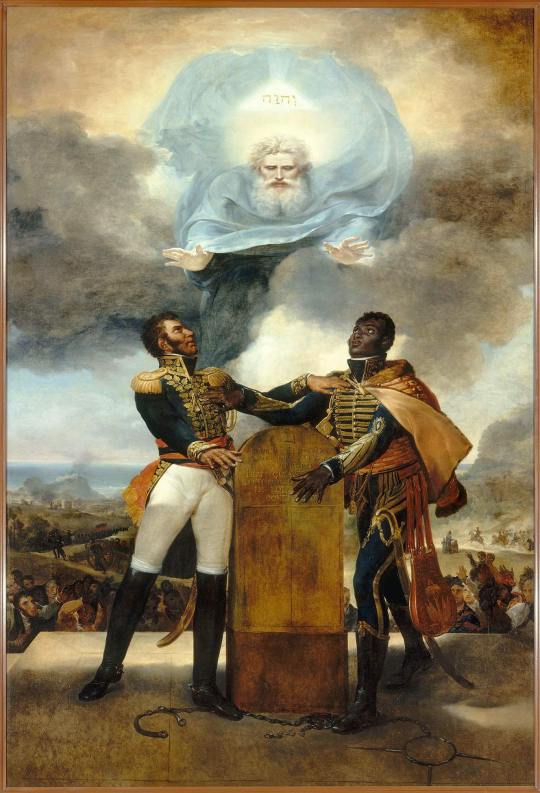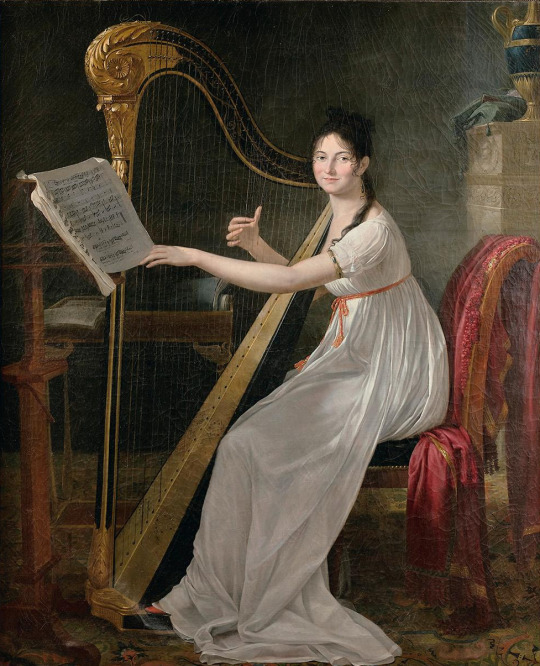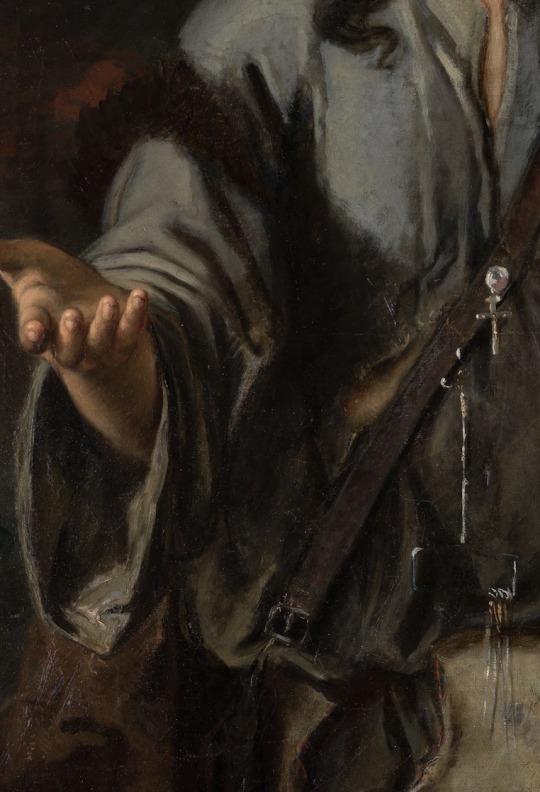#guillaume guillon-lethière
Explore tagged Tumblr posts
Text
al things considered — when i post my masterpiece #1340

first posted in facebook august 23, 2024
guillaume guillon-lethière -- "le serment des ancêtres" [i.e., "the oath of the ancestors"] (ca. 1823)
"you may not always have a comfortable life and you will not always be able to solve all of the world's problems at once but don't ever underestimate the importance you can have because history has shown us that courage can be contagious and hope can take on a life of its own" … michelle obama
"'the oath of the ancestors,' painted in 1822 by the french artist guillaume lethière, is a heroic vision of the birth of a nation, though not one he ever called home. a towering canvas depicts generals alexandre pétion and jean-jacques dessaline, heroes of the haitian revolution, in crisp military regalia. their hands rest on a stone inscribed with the ideals of their new freedom; broken shackles and chains lay at their feet. their eyes are cast to the heavens, where a billowy god figure bestows divine grace upon them from above. lethière made it as a gift to the nation, and as a gesture of his solidarity with rising abolitionist and liberation movements. but it’s also an emblem of the artist’s own tangle of paradoxes. lethière was born in 1760 in the french colony of guadeloupe, where his mother, marie-françoise pepeye, who was mixed race, had been enslaved. his father, pierre guillon, a wealthy white sugar plantation owner, didn’t officially recognize lethière as his own until later in life, but doted on him nonetheless. guillon took his son to paris as a teen, where he became a central figure in both the thriving mixed-race creole community and the french art establishment. then, not long after his death in 1832, he was all but forgotten" … murray whyte
"for the 21st century viewer, the sight of the two men of color gazing worshipfully upward at a white god is both offensive and painfully embarrassing although a neoclassical artist trained in europe could hardly be expected to visualize god in any other way. the notion of casting morgan freeman as god was still nearly two centuries in the future" … susan wood
"hope is not blind optimism. it's not ignoring the enormity of the task ahead or the roadblocks that stand in our path. it's not sitting on the sidelines or shirking from a fight. hope is that thing inside us that insists, despite all evidence to the contrary, that something better awaits us if we have the courage to reach for it, and to work for it, and to fight for it. hope is the belief that destiny will not be written for us, but by us, by the men and women who are not content to settle for the world as it is, who have the courage to remake the world as it should be" … barack obama
"i ALways fear the worst, but continue to hope for the best" … al janik
#guillaume guillon-lethière#le serment des ancêtres#the oath of the ancestors#michelle obama#hope#murray whyte#alexandre pétion#jean-jacques dessaline#haitian revolution#mixed race#susan wood#a white god#barack obama#fear the worst#hope for the best#al things considered
3 notes
·
View notes
Text



Napoleon at the signing of the Treaty of Leoben
C. 1804-1805
Guillaume Guillon-Lethière
About the artist:
According to the Dallas Museum of Art, he was one of the “first major artists of African descent in the history of European art” as he was the son of a French diplomat and an emancipated African slave. He is known for his large neoclassical paintings.
He became friends with Louis Bonaparte, and also the artistic advisor to Lucien Bonaparte, two of Napoleon’s brothers. Lucien helped Lethière get a pardon when he killed a man in a fight. Lethière obtained the coveted position of director of the Académie de France in Rome in 1807, which he held for 9 years.
His loyalty to Napoleon and the Bonaparte family caused the restored Bourbon monarchy to look unfavorably on him, but he was eventually restored to good graces in Restoration France as the years went by.
Besides Napoleon, the other members of the Bonaparte family he painted include Josephine, Lucien and Elisa.
(Source) (Source) (Source)
#Napoleon#Guillaume Guillon-Lethiere#Guillaume Guillon-Lethière#Guillon-Lethière#Lethière#napoleonic era#napoleonic#French empire#first french empire#Bonaparte#19th century#history#art history#France#frev#french revolution#lucien bonaparte#louis bonaparte#Lucien#Napoleon’s brothers#black history#art#painting#napoleonic wars#Treaty of Leoben#Leoben#Guillaume Guillon Lethière#napoleon bonaparte#Versailles
34 notes
·
View notes
Text

Le Serment des Ancêtres. Par Guillaume Guillon-Lethière.
#Guillaume Guillon-Lethière#Guillaume Guillon Lethière#Jean-Jacques Dessalines#jean jacques dessalines#jacques I#emperor of haiti#monarquías americanas#haiti#monarquias americanas#révolution haïtienne#haitian revolution#french revolution#révolution française
16 notes
·
View notes
Text

Philoctetes on the Island of Lemnos by Guillaume Guillon-Lethière
#guillaume guillon lethière#art#philoctetes#lemnos#island#greek mythology#ancient greece#ancient greek#isle#the iliad#homer#europe#european#mediterranean#wound#foot#classical antiquity#neoclassical#neoclassicism#bow#archer#trojan war#exile
81 notes
·
View notes
Text

Oil Painting, 1799, French.
By Guillaume Guillon Lethière
Portraying Adèle Papin in a white empire-waist dress.
Tajan.
#Tajan#1799#1790s painting#directoire#Adele papin#Guillaume Guillon Lethière#french revolution#1790s France#1790s dress#painting#french#1790s womenswear
38 notes
·
View notes
Text

Guillaume Guillon-Lethière.1760-1832. Death of Cato of Utica.1795. (Marcus Porcius Cato Uticensis.95 BC-46 BC). Oil on canvas. The Hermitage Museum,Saint Petersburg.
24 notes
·
View notes
Text

“Portrait d'Adèle Papin Jouant de la Harpe" par Guillaume Guillon Lethière (1799) présenté à l'exposition “Guillon Lethière, Né à la Guadeloupe” du Louvre, janvier 2025.
21 notes
·
View notes
Text
cato's wound 👍
guillaume guillon lethière

françois-andré vincent

pierre narcisse guérin

gioacchino assereto

giovanni battista langetti




johann carl loth

21 notes
·
View notes
Text

Eugenie Servieres - Maleck-Adhel attendant Mathilde au tombeau de Josselin de Montmorency - 1820
oil on canvas,
Brest’s Museum of Fine Arts, France
Maleck-Adhel waiting for Mathilde at the tomb of Josselin de Montmorency'. The scene is inspired by Sophie Cottin's novel, Mathilde or Memoirs from the History of the Crusades (1805). Mathilde of England asked her brother, King Richard the Lionheart, for the key to the mausoleum of Josselin de Montmorency to meet her lover, Maleck-Adhel, brother of Saladin. Here we see Maleck-Adhel, dressed in oriental fashion, waiting for Mathilde in the dark mausoleum, leaning on the tomb.
Eugénie Honorée Marguerite Servières, née Charen (1786 – 20 March 1855) was a French painter in the Troubadour style. She specialized in genre period paintings.

Portrait of Eugénie Servières by Jean-Baptiste Wicar 1810
In 1807 she married the playwright Joseph Servières. She trained with her stepfather, Guillaume Guillon-Lethière, Director of the French Academy in Rome.
Beginning in 1808, she exhibited her paintings, on a wide variety of subjects, in several venues. In 1808 and 1817, The Paris Salon awarded her medals. In 1825, she displayed two works at the Salon in Lille.
Her paintings include Hagar in the Desert, Lancelot and Genevieve, Louis XIII and Mlle. de Lafayette, Alain Chartier and Marguerite d'Écosse, Valentine de Milan, Desdemona Singing the Romance of the Willow, and Blanche de Castille Delivering the Prisoners of Châtenay.
Her Mathilde converts Malek-Adhel to Christianity (1812, from a novel about the Crusades by Sophie Cottin) was purchased by the Empress Marie Louise for her personal collection, while the evocative Inez de Castro and her Children at the feet of the King of Portugal is preserved at the Trianon Palace at Versailles, near Paris.
Most of her works were personally commissioned, and very few are in museums. She had several students.
10 notes
·
View notes
Text

La Mort de Virginie - Guillaume Guillon Lethière (1760–1832)
Louvre, Paris
...
2 notes
·
View notes
Text

source: bishopsbox
Portrait of Paul Joseph Notré, by Guillaume Guillon-Lethière. Black chalk and stumping, heightened with white chalk.
11 notes
·
View notes
Text



The Little Beggar, c. 1808-09, Napoleonic era
By Hortense Haudebourt-Lescot, French
The Little Beggar is one of the earliest known works by the artist, who arrived in Rome a few months after her professor, Guillaume Guillon-Lethière, had been appointed director of the Academy of France in its new home in the Villa Medici. The subject is exceptional in showing a beggar in such a compassionate light; while he is clearly asking the viewer for money, he is a sympathetic, not a threatening figure, reflecting a significant change of attitude towards the less fortunate.
Literature
François Guizot, De l’état des Beaux-Arts en France et du Salon de 1810, Paris, Maradan, 1810, p. 99
Pierre François Gueffier, Entretiens sur les ouvrages de peinture, sculpture et gravure, exposés au Musée Napoléon en 1810, Paris, Gueffier jeune, 1811, p. 157
C. P. Landon, Salon de 1810, p.104
Paul Menoux, Hortense Haudebourt-Lescot, Catalogue Raisonné, Paris, Arthena (to be published).
TEFAF Maastricht
#Hortense Haudebourt-Lescot#Le Petit Mendiant#TEFAF Maastricht#TEFAF#maastricht#19th century#napoleonic era#napoleonic#art#women artists#neoclassical#1808#1809#19th century art#female artists#female painters#women in art#auction#auctions
19 notes
·
View notes
Text

Guillaume Guillon Lethière - The death of Catho of Utica, 1795.
Photo: https://app.smartify.org/en-GB/objects/guillaume-guillon-lethiere-death-of-cato-of-utica
3 notes
·
View notes
Text

Lucien Bonaparte contemplating his mistress, Alexandrine de Bleschamp Jouberthon by Guillaume Guillon-Lethière
#lucien bonaparte#bonaparte#art#guillaume guillon lethière#alexandrine de bleschamp jouberthon#alexandrine de bleschamp#madame jouberthon#portrait#france#french#napoleonic#neoclassical#neoclassicism#europe#european#antiquity#antique#dress#venus#roman#greek#history#incense burner#sofa#chair#busts#romantic#romanticism
129 notes
·
View notes
Text

I couldn't Ducornet it better
Louis Joseph César Ducornet, Self-portrait, 1852, Musée des Beaux-Arts de Tours
Ducornet was a French painter who was born without arms. He began drawing with his foot from a young age, and as an adult he studied under Guillaume Guillon-Lethière, François Louis Joseph Watteau and François Gérard.
0 notes
